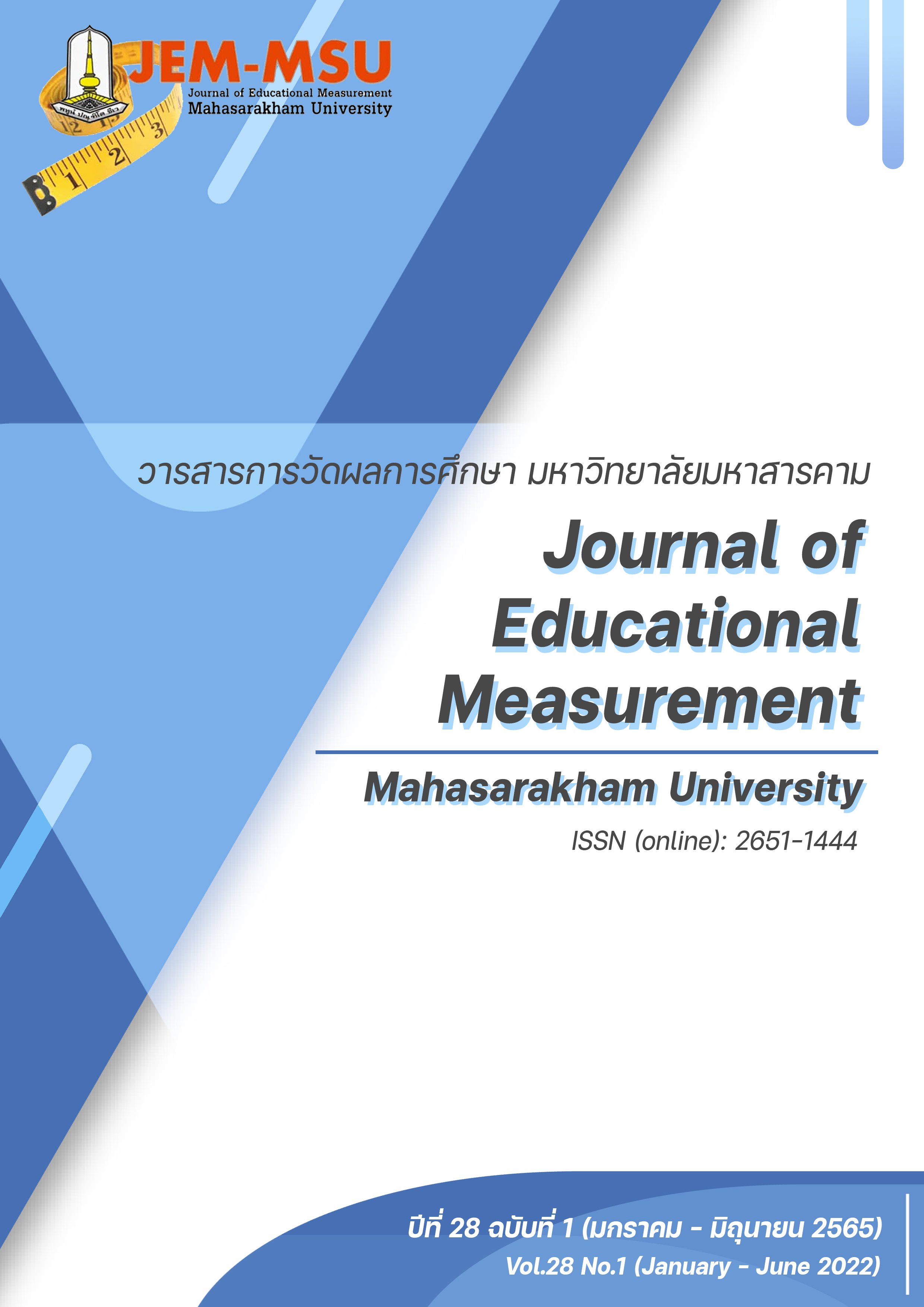การพัฒนาแบบวัดทักษะการโต้แย้งทางวิทยาศาสตร์ของนักเรียน: การประยุกต์ใช้โมเดลเชิงโครงสร้าง
Main Article Content
บทคัดย่อ
การวิจัยนี้มีวัตถุประสงค์เพื่อ (1) พัฒนาแผนที่โครงสร้างของทักษะการโต้แย้งทางวิทยาศาสตร์ของนักเรียนชั้นมัธยมศึกษาตอนต้น และ (2) พัฒนาและตรวจสอบคุณภาพของแบบวัดทักษะการโต้แย้งทางวิทยาศาสตร์ กลุ่มตัวอย่าง คือ นักเรียนระดับชั้นมัธยมศึกษาตอนต้น ปีการศึกษา 2563 จำนวน 514 คน สังกัดเขตพื้นที่การศึกษามัธยมศึกษาขอนแก่น จากจำนวนประชากรทั้งหมด 31,744 คน ด้วยวิธีการสุ่มแบบหลายขั้นตอน พัฒนาแบบวัดประยุกต์ตามโมเดลเชิงโครงสร้าง 4 ขั้นตอน คือ (1) พัฒนาแผนที่โครงสร้างของทักษะการโต้แย้งทางวิทยาศาสตร์ (2) ออกแบบข้อคำถาม (3) กำหนดปริเขตของคำตอบ และ (4) วิเคราะห์ข้อมูลด้วยโมเดล MRCML และพิจารณาผลการวิเคราะห์ด้วย Wright Map ผลการวิจัยปรากฏดังนี้
(1) แผนที่โครงสร้างทักษะการโต้แย้งทางวิทยาศาสตร์ มี 2 มิติ คือ มิติการสร้างองค์ประกอบการโต้แย้ง มี 4 ระดับ คือ ระดับ 1 สร้างข้อสรุปที่ไม่เกี่ยวข้องกับสถานการณ์ ซึ่งเป็นระดับต่ำสุด ไปยังระดับสูงสุด คือ ระดับ 4 โต้แย้งที่ต่างออกไปด้วยการตัดสินบนเหตุผล และมิติการใช้ความรู้ทางวิทยาศาสตร์ มี 4 ระดับ คือตั้งแต่ระดับ 1 คือ อธิบายด้วยเนื้อหาที่ไม่เกี่ยวข้อง หรือนักเรียนไม่สามารถจำเนื้อหาทางวิทยาศาสตร์ได้ จนไปถึงระดับสูงสุดคือระดับที่ 4 นักเรียนนำข้อมูลทางวิทยาศาสตร์ที่ซับซ้อนมาใช้อธิบาย
(2) แบบวัดทักษะการโต้แย้งทางวิทยาศาสตร์ มีทั้งหมด 22 ข้อ เป็นข้อคำถามปลายเปิด มีการตรวจให้คะแนนสองค่า และแบบหลายค่า ตั้งแต่ 0 ถึง 3 คะแนน โดยแบบวัดประกอบด้วยจำนวนข้อคำถามในมิติการสร้างองค์ประกอบของการโต้แย้ง และมิติการใช้ความรู้ทางวิทยาศาสตร์ 12 ข้อ และ 10 ข้อ ตามลำดับ
(3) ผลการตรวจสอบคุณภาพของแบบวัดสะท้อนหลักฐานความตรง พบว่า ด้านความตรงของเนื้อหาของข้อคำถาม ข้อคำถามมีค่าความยากครอบคลุมช่วงความสามารถของนักเรียน นั่นคือ ข้อคำถามสามารถอธิบายทักษะการโต้แย้งทางวิทยาศาสตร์ ด้านหลักฐานความตรงเกี่ยวกับการตอบสนองของนักเรียน พบว่านักเรียนเข้าใจเนื้อหา หรือสถานการณ์ของข้อคำถาม ตรงกับจุดประสงค์ของผู้วิจัยต้องการให้นักเรียนตอบสนองต่อข้อคำถาม และหลักฐานความตรงด้านโครงสร้างภายใน ข้อคำถามสามารถนำไปใช้วัดทักษะการโต้แย้งทางวิทยาศาสตร์ได้ (Infit MNSQ ระหว่าง 0.74 ถึง 1.35) ด้วยโมเดลการวัดแบบพหุมิติสอดคล้องกลมกลืนกับคำตอบของนักเรียนอย่างมีนัยสำคัญทางสถิติ (2=17.8, df=2, p<.001) พร้อมกับโมเดลการวัดแบบพหุมิติมีค่า AIC BIC ต่ำกว่าโมเดลเอกมิติ เมื่อพิจารณาหลักฐานความเที่ยงของแบบวัด พบว่าการประเมินทั้งสองมิติมีค่าความเที่ยงแบบ EAP/PV เท่ากับ 0.89 ซึ่งอยู่ในเกณฑ์ยอมรับได้ และมีความคลาดเคลื่อนมาตรฐานในการวัดต่ำ โดย SEM
1 (มิติการสร้างองค์ประกอบการโต้แย้ง) ในช่วง (0.38 – 0.56) และ SEM
2 (มิติการใช้ความรู้ด้านวิทยาศาสตร์) ในช่วง (0.58 – 1.87)
Article Details

อนุญาตภายใต้เงื่อนไข Creative Commons Attribution-NonCommercial-NoDerivatives 4.0 International License.
เนื้อหาและข้อมูลในบทความที่ลงตีพิมพ์ในวารสารการวัดผลการศึกษา มหาวิทยาลัยมหาสารคาม ถือเป็นข้อคิดเห็นและความรับผิดชอบของผู้เขียนบทความโดยตรง ซึ่งกองบรรณาธิการวารสาร ไม่จำเป็นต้องเห็นด้วย หรือร่วมรับผิดชอบใดๆ
บทความ ข้อมูล เนื้อหา รูปภาพ ฯลฯ ที่ได้รับการตีพิมพ์ในวารสารการวัดผลการศึกษา มหาวิทยาลัยมหาสารคาม ถือเป็นลิขสิทธิ์ของวารสารการวัดผลการศึกษา มหาวิทยาลัยมหาสารคาม หากบุคคลหรือหน่วยงานใดต้องการนำทั้งหมดหรือส่วนใดส่วนหนึ่งไปเผยแพร่ต่อหรือกระทำการใดๆ จะต้องได้รับอนุญาตเป็นลายลักษณ์อักษรจากวารสารการวัดผลการศึกษา มหาวิทยาลัยมหาสารคาม ก่อนเท่านั้น
เอกสารอ้างอิง
Adams, R. J., Wilson, M., & Wang, W. chung. (1997). The multidimensional random Coefficients MULTINOMIAL logit model. Applied Psychological Measurement, 21(1), 1–23. https://doi.org/10.1177/0146621697211001.
Adams, R. J. & Khoo, S. T. (1996). QUEST: the interactive test analysis system version 2.1. The Australian Council for Educational Research.
Briggs, D. C. & Wilson, M. (2003). An Introduction to multidimensional measurement using Rasch models. Journal of Applied Measurement, 4(1), 87-100.
Faize, F. A., Husain, W., & Nisar, F. (2017). A Critical Review of Scientific Argumentation in Science Education. EURASIA Journal of Mathematics, Science and Technology Education, 14(1). https://doi.org/10.12973/ejmste/80353
Gotwals, A. W., & Songer, N. B. (2009). Reasoning up and down a food chain: Using an assessment framework to investigate students middle knowledge. Science Education. https://doi.org/10.1002/sce.20368
Hambleton, R.K., Swaminathan, H. and Rogers, H.J. (1991) Fundamentals of Item Response Theory. Sage Publications.
Lin, T. H., & Dayton, C. M. (1997). Model selection information criteria for non-nested latent class models. Journal of Educational and Behavioral Statistics, 22(3), 249–264. https://doi.org/10.2307/1165284
Linacre, J. M. (1994). Sample size and item calibration stability. Rasch Measurement Transactions, 7(4), 328.
Osborne, J., Erduran, S., & Simon, S. (2004). Enhancing the quality of argumentation in school science. Journal of Research in Science Teaching, 41(10), 994–1020. https://doi.org/10.1002/tea.20035
Osborne, J. F., Henderson, J. B., Macpherson, A., Szu, E., Wild, A., & Yao, S. (2016). The development and validation of a learning progression for argumentation in science. Journal of Research in Science Teaching, 53(6), 821-846. https://doi.org/10.1002/tea.21316
Osborne, J. (2010). Arguing to Learn in Science: The Role of Collaborative, Critical Discourse. Science, 328(5977), 463-466. https://doi.org/10.1126/science.1183944
Schwarz, G. (1978). Estimating the dimension of a model. The Annals of Statistics, 6(2). 461-464. https://doi.org/10.1214/aos/1176344136
Siegel, H. (1995). Why Should Educators Care about Argumentation? Informal Logic, 17(2). 159-176, https://doi.org/10.22329/il.v17i2.2405
Songsil, W., Pongsophon, P., Boonsoong, B., & Clarke, A. (2019). Developing scientific argumentation strategies using revised argument-driven inquiry (rADI) in science classrooms in Thailand. Asia-Pacific Science Education, 5(1). https://doi.org/10.1186/s41029-019-0035-x
Toulmin, S. E., Rieke, R. D., & Janik, A. (1984). An introduction to reasoning. Macmillan.
Suksiri, W., & Worain, C. (2016, December 21). Investigating Tentative Cut scores for Science Learning Area on the Ordinary National Educational Test Scores using the Construct Mapping Method: An Analysis for Further Judgments. The National Institute of Educational Testing Service.
Wilson, M. (2005). Constructing measures: An item response modeling approach (Har/Cdr edition). Routledge.
Wright, B. D., & Stone, M. H. (1979). Best Test Design: Rasch Measurement. Mesa Press.
Wu, M. L., Adams, R. J., Wilson, M. R., & Haldane, S. A. (2007). ACER ConQuest: Generalised Item Response Modeling Software [Computer software]. Version 2. Camberwell, Australian Council for Educational Research.
Yao, L., & Schwarz, R. D. (2006). A Multidimensional Partial Credit Model with Associated Item and Test Statistics: An Application to Mixed-Format Tests. Applied Psychological Measurement, 30(6), 469–492. https://doi.org/10.1177/0146621605284537


